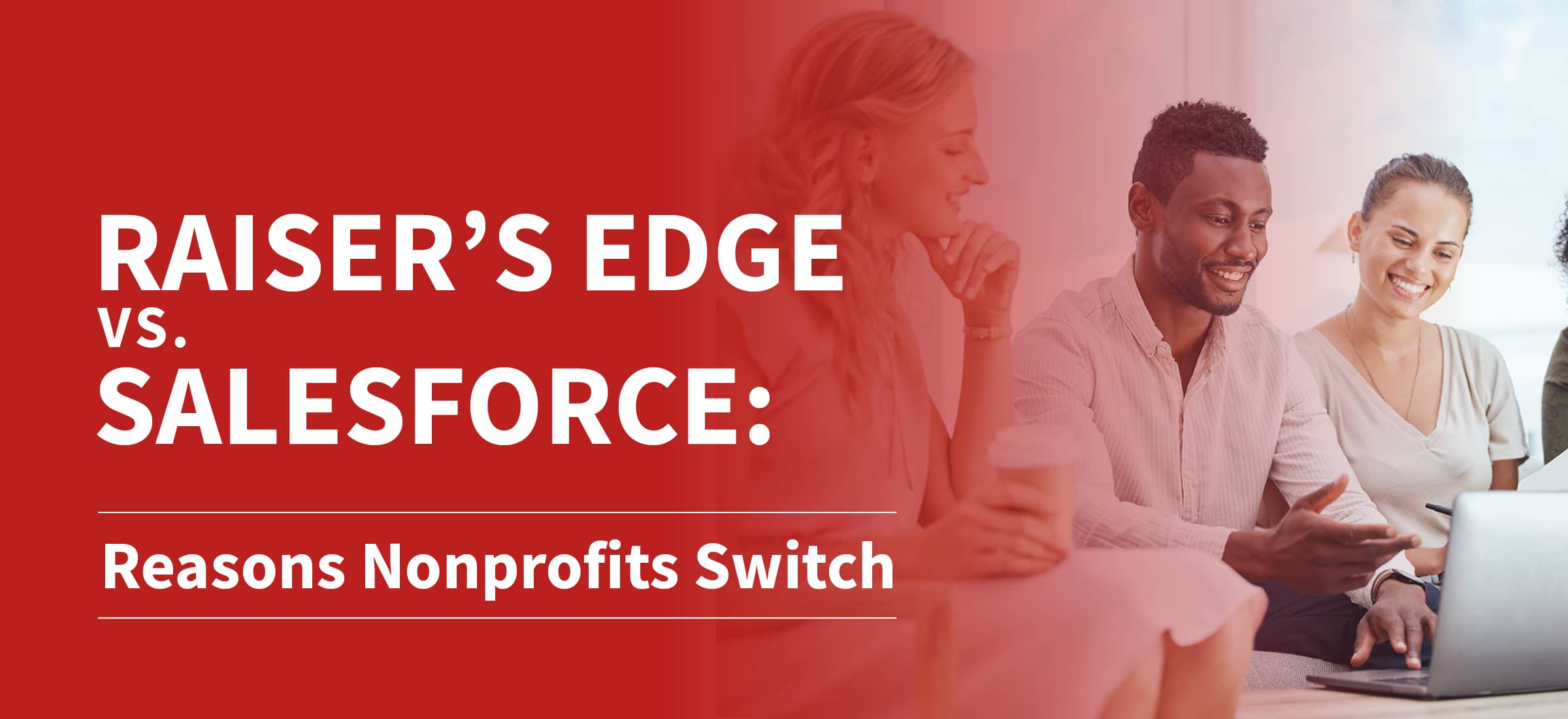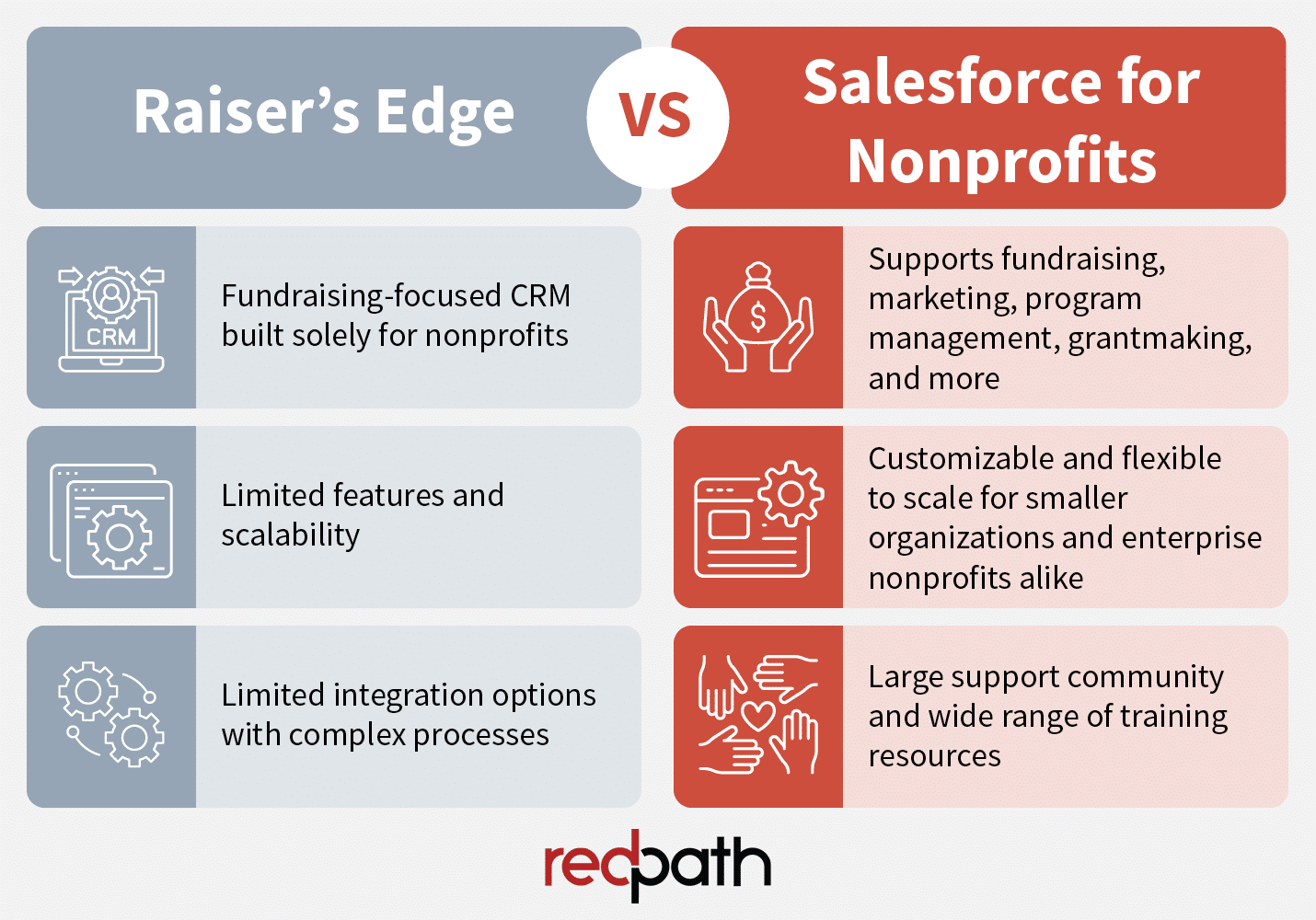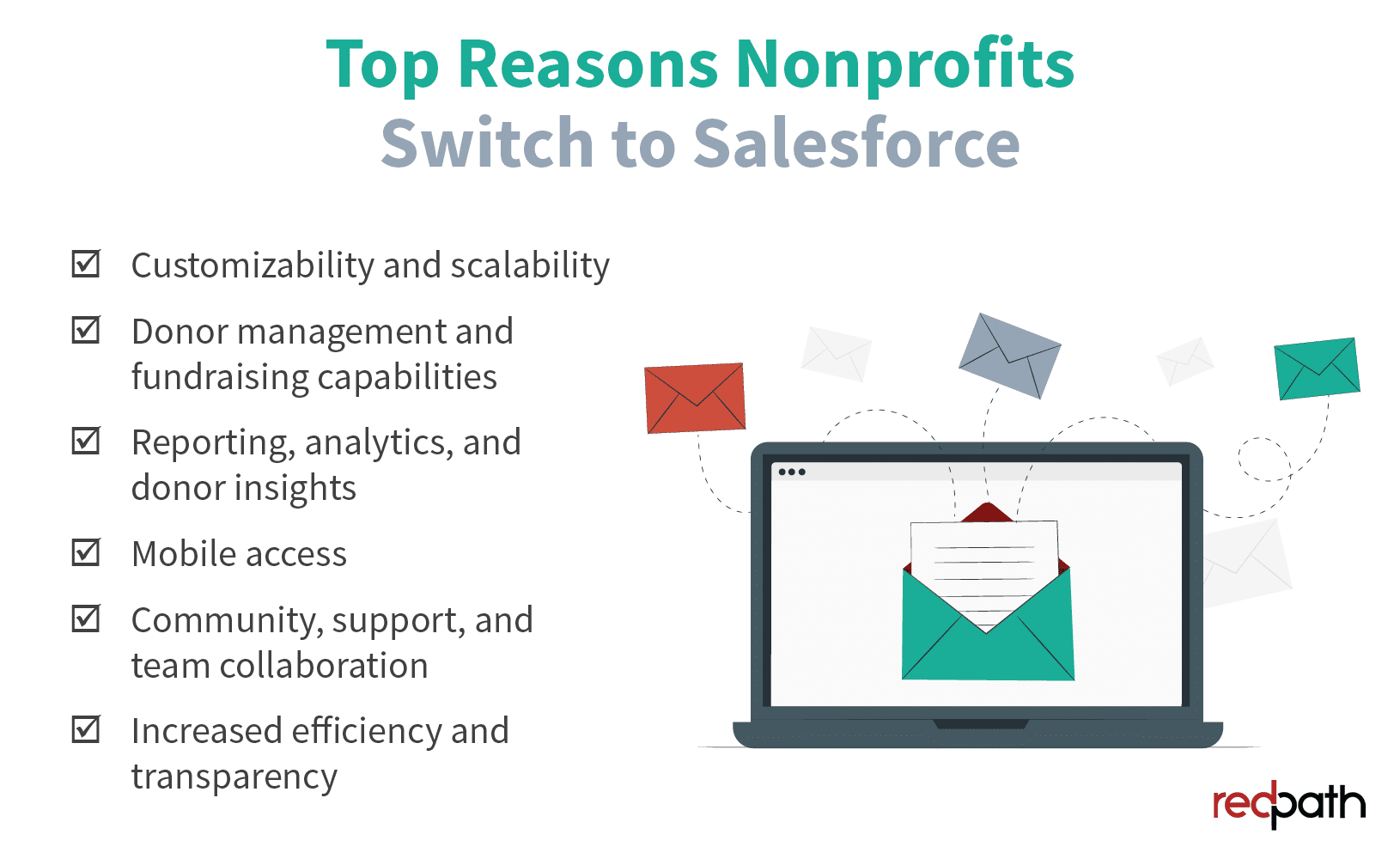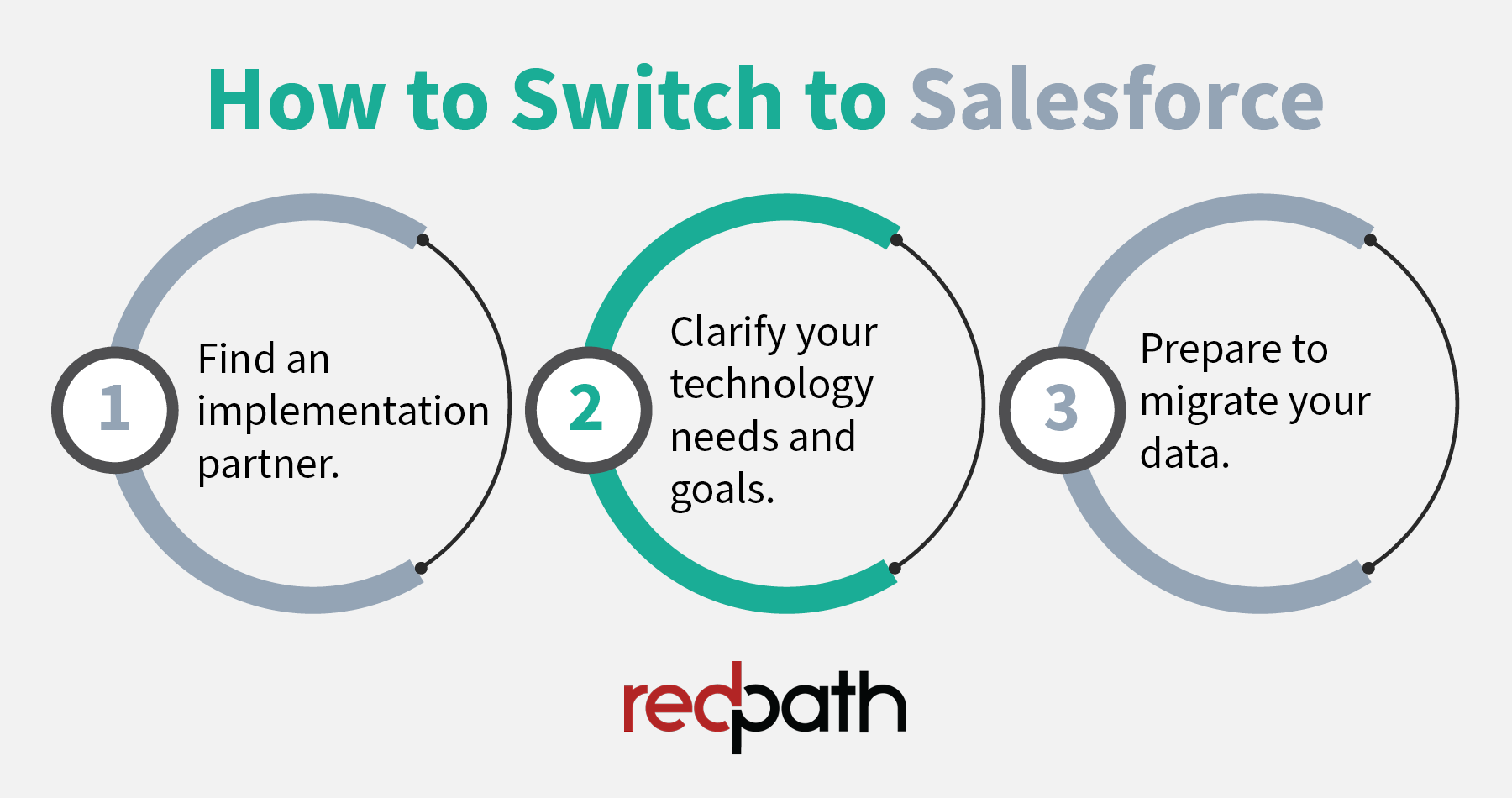Raiser’s Edge vs Salesforce: 7 Reasons Nonprofits Switch

Raiser’s Edge and Salesforce are two of the top CRM platforms for nonprofits, but did you know that over 54,000 organizations have found that Salesforce is the better choice?
If your nonprofit is considering switching to Salesforce or just evaluating your options for a comprehensive database, look no further. This guide will walk you through everything you need to know to make your decision, including:
- What are the Differences Between Raiser’s Edge and Salesforce?
- Raiser’s Edge vs Salesforce: Pros and Cons
- Top Reasons Nonprofits Switch from Raiser’s Edge to Salesforce
- What to Know Before Switching to Salesforce
Your organization’s CRM is the foundation of your technology stack, so it’s crucial to consider your options carefully and choose a system that will enable your nonprofit to thrive. As we explore the reasons thousands of nonprofits choose Salesforce, think about your nonprofit’s current technology stack and your objectives in improving it.
What are the Differences Between Raiser’s Edge and Salesforce?
Salesforce for Nonprofits and Raiser’s Edge are both CRM systems designed for nonprofit organizations, but there are key differences between the two platforms. Let’s break down some of the most notable differences:

- Raiser’s Edge is a fundraising-focused CRM built solely for nonprofits. It offers plenty of features to help your organization fundraise, but it includes limited features outside the realm of fundraising. Raiser’s Edge also has few, complex integration options, which often makes it more difficult to scale the CRM to the needs of a growing nonprofit.
- Salesforce for Nonprofits is a more comprehensive CRM system that supports fundraising, marketing, program management, grantmaking, and more. The platform is highly customizable and flexible, making it easy to scale for smaller organizations and enterprise nonprofits alike. There’s also a larger support community and a wide range of training resources for your team to use.
Essentially, Salesforce’s Nonprofit Cloud is a core platform that you can customize and expand with thousands of available apps to choose from. Raiser’s Edge is built on a more inflexible architecture, making it simpler to set up but much more limited in terms of customization and integration options.
Raiser’s Edge vs Salesforce: Pros and Cons
For a deeper look at the two options, let’s explore some common pros and cons of both Raiser’s Edge and Salesforce.
Raiser’s Edge
Key pros of Raiser’s Edge include its intuitive interface and extensive fundraising features. Since Raiser’s Edge is an out-of-the-box solution, it’s quicker to set up without an elaborate implementation process. Additionally, the fact that Raiser’s Edge was built for nonprofits alone (while Salesforce caters to both nonprofits and for-profit companies) is highly appealing to most organizations.
However, one of Raiser’s Edge’s biggest drawbacks is that it’s less scalable than Salesforce. Its restricted range of features and integration choices can pose challenges in seamlessly connecting your organization’s data through technology. This, in turn, hinders the effective utilization of your CRM as a central hub for operations.
Salesforce for Nonprofits
There are plenty of appealing pros that come with choosing Salesforce, including:
- Multiple solutions designed for nonprofits. Salesforce offers two main solutions for nonprofits: Nonprofit Cloud and the Nonprofit Success Pack (NPSP). Nonprofit Cloud is a newer, unified solution that combines nonprofit features with the best Salesforce has to offer from other clouds. NPSP is a managed package, meaning it’s a collection of nonprofit-focused apps layered on top of the core Salesforce platform.
- Extensive customization opportunities. No matter which Salesforce solution you choose, you’ll be able to tailor the platform to meet your organization’s unique needs. Easily integrate your other fundraising and marketing tools, or browse available free and paid apps on the Salesforce AppExchange.
- Access to all the latest Salesforce developments. The Salesforce team is constantly working to bring its users the latest technology developments like Artificial Intelligence. As a Salesforce for Nonprofits user, you’ll be able to leverage these new features to further your mission.
- Free user licenses for nonprofits. Since Salesforce caters to for-profit companies too, they offer extra discounts for nonprofits. Through the Power of Us program, eligible nonprofits can access several free user licenses along with additional discounts.
Despite all of Salesforce’s benefits, some nonprofits may be hesitant to make the switch because of its lengthy implementation process which often requires the help of third-party tech experts. Additionally, while Nonprofit Cloud and NPSP are designed with nonprofit industry best practices at the forefront, Salesforce is more well-known for catering to for-profit businesses.
Top Reasons Nonprofits Switch from Raiser’s Edge to Salesforce
Many nonprofits have evaluated the pros and cons and found that migrating their data over to Salesforce alleviates the common headaches that occur with using Raiser’s Edge as their CRM platform. Based on our firsthand experience with nonprofit clients, we’ve compiled a list of the top reasons organizations decide to leverage Salesforce for Nonprofits as their CRM:

1. Customizability and scalability
One of our favorite functionalities of Salesforce is that it can grow with your nonprofit, providing solutions for small organizations and enterprise-level nonprofits alike, allowing it to be a unique fit for your organization’s needs.
Salesforce for Nonprofits is a highly customizable platform, which allows organizations to tailor the software to their specific needs. You can also add on free and paid apps from Salesforce or the AppExchange to further extend its capabilities. Raiser’s Edge, on the other hand, may limit organizations’ ability to fully optimize the software to meet their needs.
2. Improved donor management and fundraising capabilities
Salesforce helps nonprofits track and analyze fundraising efforts, making it easier to identify and target potential donors than Raiser’s Edge.
In addition, Salesforce provides robust and flexible donor management capabilities, including holistic donor profiles, a comprehensive Fundraising Portfolio, and more. Salesforce allows nonprofits to communicate with donors and volunteers more easily, improving both donor engagement and retention.
3. Reporting, analytics, and data insights
Salesforce for Nonprofits has robust, customizable reporting and analytics capabilities, which can help organizations gain insights into their performance and make better data-driven decisions. You can also add more extensive analytics applications to your CRM if desired.
4. Mobile access
In partnership with easy data management, Salesforce for Nonprofits can be accessed from mobile devices and can be used on the go, which is useful for organizations that have staff working remotely or in the field. Additionally, some add-ons allow use without a mobile signal or wifi connectivity, which syncs up once connectivity is available.
5. Software integration
Salesforce for Nonprofits is a cloud-based platform that can integrate with a wide variety of other tools and platforms, such as marketing automation software, social media platforms, payment gateways, and e-commerce platforms. With Raiser’s Edge’s limited integration level, organizations’ ability to connect the software to their other tools and systems is also limited.
6. Community, support, and team collaboration
Salesforce has a large and active user community and a wide range of resources, including documentation, tutorials, and forums, which help organizations get the most out of the software. Plus, many nonprofit user groups exist to help nonprofits learn how to maximize Salesforce for their organizational needs.
Salesforce also has functionality that allows teams to share information and collaborate more easily than with Raiser’s Edge, improving communication and decision-making.
7. Increased efficiency and transparency
Salesforce streamlines processes such as event management, volunteer coordination, and grant tracking, allowing nonprofits to focus on their mission more effectively than Raiser’s Edge. The clear view of organizational performance that Salesforce provides makes it easier to identify areas for improvement.
What to Know Before Switching to Salesforce
Now that you know the benefits, you may feel ready to make the switch from Raiser’s Edge to Salesforce. Before you dive in, however, you should have an understanding of the process and the resources needed.
We recommend speaking with other smaller, mid-sized, and large nonprofits to hear about their experience with Salesforce for Nonprofits before making your decision. Then, follow these three steps to switch from Raiser’s Edge to Salesforce:

- Find an implementation partner. Migrating sensitive data and setting up a robust system like Salesforce requires in-depth technical expertise. You’ll need to partner with a specialized nonprofit Salesforce consultant who can help you navigate the process with ease and success.
- Clarify your technology needs and goals. Once you’ve chosen an implementation partner, discuss your situation with them so they get an understanding of your organization’s unique needs and goals for using Salesforce. Your consultant will use this information to guide their approach and ensure you can leverage Salesforce effectively.
- Prepare to migrate your data. Finally, your partner should take the lead on your Raiser’s Edge data migration to ensure that all of your data is safely and seamlessly migrated. Speak with your partner about your role in this process, as you’ll likely need to clean and organize your data ahead of the migration.
The Redpath Consulting Group team is highly experienced and passionate about helping nonprofits grow and achieve their missions. Many of our team members came from nonprofit organizations like yours, and are now Salesforce-certified, experienced, and trusted advisors. When you’re ready to make the switch from Raiser’s Edge to Salesforce, our team can help you every step of the way.
Raiser’s Edge vs Salesforce: Final Thoughts
Ultimately, the decision to implement a new CRM is a highly personal one for each nonprofit. If your organization’s leadership is considering Salesforce, we encourage you to seek out technology experts like those at Redpath who can help you thoroughly understand your options and make the best decision for your nonprofit.
Eager to learn more about Salesforce before you make your decision? Check out these additional resources:
- Your Complete Salesforce for Nonprofits Implementation Guide. Learn about Salesforce’s two main offerings for nonprofits and what the process of switching to Salesforce entails.
- Marketing Cloud for Nonprofits: What it Can Do For You. Explore one of the most impactful solutions Salesforce offers and how leveraging can help your nonprofit thrive.
- Why You Need a Salesforce Partner to Help You with Your Raiser’s Edge Migration. Migrating all your data from Raiser’s Edge to Salesforce is an involved process. Learn how a qualified Salesforce partner can make all the difference in a successful migration.
With the rapid evolution of technology, Salesforce solutions are ever-changing and improving features. Contact our team for up-to-date information.




